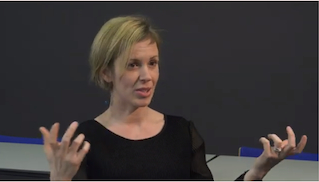In the old days the job of physicists was to explain the things we observe in the world around us. In modern physics explanation often comes before observation. The famous Higgs boson is an example. Physicists realised that something like the Higgs must exist for their theory to make sense; they went looking for it and, a few decades later, finally discovered it.

Maria Ubiali. You can see a video of our interview with her below.
But given a theory written, as always, in the language of maths, it's not always clear what kind of experiments you should perform in order to confirm or debunk it. This is where phenomenologists come in. Maria Ubiali, of the University of Cambridge, is one of them. Her job is to work out what observable consequences our theories of nature might have. In particular, she focusses on the standard model of particle physics which describes the fundamental particles of nature.
"What I really do is to formulate theoretical predictions, to give numbers to the experimentalists," says Ubiali. "They verify what I give them to see if the standard model is the law that correctly describes nature, or if there is something more than that."
What can we predict?
A good example of the interplay between theory and experiment is our evolution of the understanding of the proton. When protons were discovered a century ago, scientists thought they were elementary, indivisible particles. In the 1960s it was realised that protons were actually built of three smaller particles, which we now call quarks, bound together by some force carrying particles called gluons. And today our picture of protons is even more complicated: "There is an interesting life inside the proton. Inside this tiny radius of the proton quarks keep creating and annihilating in pairs, quarks and antiquarks, with gluons radiating all the time off the quarks and antiquarks."
At high energies (when quark/antiquark pairs are more likely to pop in and out of existence) you might think of a proton as more like a swarm of particles: three quarks, and a crowd of gluons and quark/antiquark pairs. The structure of the proton is then described in statistical terms capturing how the properties of the proton, such as its momentum, are distributed across the swarm.
Machine learning

What are the fundamental building blocks of matter?
Theoretical predictions for processes involving elementary particles such that electrons or photons can be determined from the standard model by solving the relevant equations. "What is interesting about the structure of the proton is that it can't be determined by using first principles," says Ubiali. For the mathematical description of the protons, called quantum chromodynamics (QCD), the equations cannot be completely solved. "That's why we need experimental data to infer the structure of the proton in terms of its elementary constituents."
The problem is that experiments like the Large Hadron Collider (LHC) produce a huge amount of data. Trailing through this data to see what it might teach us about the structure of the proton is a near impossible task. Which is why Ubiali and her colleagues harness the power of computers. In particular, they use something called machine learning (find out more here) to find patterns in these large data sets and then use this information to fine tune their mathematical description of the proton.
"That's how we apply machine learning, so we have a much better determination of the [proton's structure]," says Ubiali. This data-driven description not only gives the best prediction of the structure, but also the uncertainty associated with this best prediction. "We have more realistic estimates of the uncertainty, of what we still don't know."
Beyond the standard model
"The success of the standard model is extraordinary," says Ubiali. Recent comparisons of the standard model's predictions to experimental data show an amazing agreement over a wide range of scales (from 10-4 to 1011 picobarns – a measurement of area). However we know that the standard model cannot be a complete description of nature as there are many mysteries – such as why neutrinos have mass and the nature of dark matter – that the standard model cannot solve.
Ubiali says that part of her work involves stretching the standard model to the maximum precision possible in order to experimentally observe any deviations from the predictions. And then she also works on some particular models that go beyond the standard model.
"As a theorist I'm really interested to see what is beyond the standard model. I'm particularly interested in the paradigm shift we are living in. When the LHC was turned on we were all expecting to see some spectacular deviation from our predictions because we would reach the energy [of the collisions] when something would break down. But that didn't happen."
"This could be a source of depression, or a source of excitement. For me it is a source of excitement - it means that nature will give us some more subtle hints about deviations."
댓글 없음:
댓글 쓰기